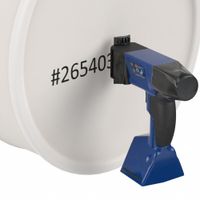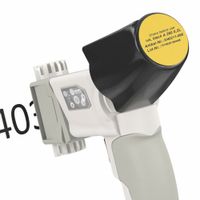Call +(254) 703 030 000 / 751 483 999 / 721 704 777
- Home
- Safety
- Signs Facility Identification Products
- Label Printers
- Handheld Inkjet Printers Supplies
.....Read More
Frequently Asked Questions
What surfaces can handheld inkjet printers print on?
Handheld inkjet printers are versatile devices capable of printing on a wide range of surfaces due to their portability and adaptability. They can print on:
1. **Paper**: Standard and specialty papers, including glossy, matte, and textured varieties.
2. **Cardboard**: Suitable for packaging, shipping boxes, and other corrugated materials.
3. **Wood**: Both raw and finished wood surfaces, useful for crafts and labeling.
4. **Metal**: Coated and uncoated metals, including aluminum and steel, often used in industrial settings.
5. **Plastic**: Various types, such as PVC, PET, and acrylic, commonly used for labeling and branding.
6. **Glass**: Smooth glass surfaces, ideal for decorative purposes and labeling.
7. **Textiles**: Fabrics like cotton, polyester, and blends, used for custom clothing and accessories.
8. **Ceramics**: Glazed and unglazed ceramic surfaces, suitable for decorative items and tiles.
9. **Leather**: Both genuine and synthetic leather, used for personalization and branding.
10. **Stone**: Smooth stone surfaces, including marble and granite, for decorative and industrial applications.
The effectiveness of printing on these surfaces depends on the printer's ink type, such as dye-based, pigment-based, or UV-curable inks, which offer varying levels of adhesion and durability. Additionally, surface preparation, such as cleaning or priming, may be necessary to ensure optimal print quality.
How long does the ink last on different surfaces?
The longevity of ink on various surfaces depends on several factors, including the type of ink, the surface material, environmental conditions, and exposure to elements like sunlight and moisture.
1. **Paper**: Ink on paper can last indefinitely if stored properly, away from light and moisture. Archival-quality inks and papers are designed to last for decades without significant fading.
2. **Fabric**: Ink on fabric, such as from fabric markers or screen printing, can last through many washes if heat-set properly. However, exposure to sunlight and frequent washing can cause fading over time.
3. **Skin**: Ink on skin, like from temporary tattoos or markers, typically lasts a few days to a week, depending on washing and skin type. Permanent tattoos, using ink injected into the dermis, can last a lifetime but may fade over decades.
4. **Metal**: Ink on metal surfaces, such as from industrial markers, can last for years if not exposed to harsh conditions. However, exposure to weather, chemicals, or abrasion can reduce longevity.
5. **Glass**: Ink on glass, like from glass markers, is usually temporary and can be wiped off easily unless baked or treated to set the ink, which can make it more permanent.
6. **Plastic**: Ink on plastic can last for months to years, depending on the type of ink and plastic. Permanent markers tend to last longer, but exposure to sunlight can cause fading.
7. **Wood**: Ink on wood can last for years, especially if sealed with a protective coating. Unsealed ink may fade or bleed over time due to moisture and sunlight exposure.
In all cases, protective measures like sealing, proper storage, and minimizing exposure to harsh conditions can significantly extend the life of ink on any surface.
Are handheld inkjet printers easy to use?
Handheld inkjet printers are generally considered easy to use due to their portability, user-friendly design, and straightforward operation. These devices are designed for convenience, allowing users to print on various surfaces such as paper, cardboard, textiles, and even wood or metal. They typically feature a simple interface, often with a small screen and intuitive controls, making them accessible even for those with limited technical skills.
The setup process is usually minimal, often involving just inserting an ink cartridge and charging the device. Many models offer wireless connectivity, enabling users to transfer designs or text from smartphones or computers directly to the printer. This feature enhances ease of use by eliminating the need for complex wiring or additional software installations.
Handheld inkjet printers are lightweight and ergonomically designed, allowing for comfortable handling during use. They often come with clear instructions and sometimes even video tutorials to guide users through the printing process. The operation usually involves selecting the desired print design, aligning the printer with the target surface, and pressing a button to initiate printing.
However, ease of use can vary depending on the model and the specific requirements of the printing task. Some users may find it challenging to achieve precise alignment or consistent print quality on uneven surfaces. Additionally, the small size of these printers may limit the print area, requiring multiple passes for larger designs.
Overall, while handheld inkjet printers are designed to be user-friendly, the ease of use can depend on the user's familiarity with the device and the complexity of the printing task.
What types of ink cartridges are compatible with handheld inkjet printers?
Handheld inkjet printers typically use specific types of ink cartridges designed to be compact and efficient for portable use. The compatible ink cartridges for these printers generally fall into the following categories:
1. **Thermal Inkjet Cartridges**: These are the most common type used in handheld inkjet printers. They use heat to vaporize ink, creating a bubble that propels the ink onto the paper. These cartridges are often easy to replace and are known for their precision and quality.
2. **Piezoelectric Inkjet Cartridges**: Less common in handheld models, these cartridges use piezoelectric crystals to push ink out of the nozzle. They are known for their durability and ability to handle a wider range of ink types, including pigment-based inks.
3. **Dye-Based Ink Cartridges**: These cartridges contain dye-based inks, which are known for their vibrant colors and smooth blending. They are ideal for printing high-quality images and graphics but may not be as water-resistant as pigment-based inks.
4. **Pigment-Based Ink Cartridges**: These cartridges use pigment-based inks, which are more resistant to water and fading. They are suitable for text and document printing where longevity and durability are important.
5. **Specialty Ink Cartridges**: Some handheld printers may use specialty inks, such as UV-curable inks or solvent-based inks, for specific applications like printing on non-porous surfaces or creating durable outdoor signage.
6. **OEM and Compatible Cartridges**: Original Equipment Manufacturer (OEM) cartridges are made by the printer's manufacturer and ensure compatibility and quality. Compatible or third-party cartridges are often more affordable but may vary in quality and reliability.
When selecting ink cartridges for a handheld inkjet printer, it is crucial to check the printer's specifications and recommendations to ensure compatibility and optimal performance.
How do you maintain a handheld inkjet printer?
To maintain a handheld inkjet printer, follow these steps:
1. **Regular Cleaning**: Clean the printer's exterior with a soft, lint-free cloth. For the printhead, use a damp cloth or a specialized cleaning solution to remove dried ink and debris. Ensure the printer is off and unplugged before cleaning.
2. **Proper Storage**: Store the printer in a cool, dry place away from direct sunlight and dust. Use a protective case if available to prevent physical damage.
3. **Ink Cartridge Care**: Use the printer regularly to prevent ink from drying in the nozzles. If not in use for extended periods, remove the cartridges and store them in a sealed plastic bag with a damp paper towel to maintain humidity.
4. **Firmware Updates**: Regularly check for and install firmware updates from the manufacturer to ensure optimal performance and compatibility with new devices.
5. **Battery Maintenance**: Charge the battery fully before first use and avoid letting it completely discharge. If the printer will not be used for a long time, store it with the battery at about 50% charge.
6. **Avoid Paper Jams**: Use the recommended paper type and size to prevent jams. If a jam occurs, gently remove the paper without tearing it, following the manufacturer's instructions.
7. **Calibration and Alignment**: Periodically run the printer's calibration and alignment functions to ensure print quality and accuracy.
8. **Use Genuine Supplies**: Use manufacturer-recommended ink and paper to avoid compatibility issues and maintain print quality.
9. **Environmental Considerations**: Avoid using the printer in extreme temperatures or high humidity, which can affect performance and ink flow.
10. **Professional Servicing**: If you encounter persistent issues, consult the user manual or contact professional service for repairs.
Can handheld inkjet printers print in color?
Yes, handheld inkjet printers can print in color. These portable devices are designed to offer the flexibility of printing on various surfaces, including paper, cardboard, textiles, and even wood or metal, depending on the model. They utilize inkjet technology, which involves spraying tiny droplets of ink onto a surface to create an image or text.
Color printing in handheld inkjet printers is achieved through the use of multiple ink cartridges, typically including cyan, magenta, yellow, and black (CMYK). By combining these colors in varying proportions, the printer can produce a wide range of colors. Some advanced models may even use additional cartridges to enhance color accuracy and vibrancy.
The quality of color printing from handheld inkjet printers can vary based on several factors, including the resolution of the printer, the quality of the ink, and the surface being printed on. While they may not match the high-resolution output of larger, stationary printers, many handheld models are capable of producing clear and vibrant color prints suitable for various applications, such as labeling, marking, or creating custom designs.
These printers are particularly popular in industries where mobility and versatility are essential, such as logistics, manufacturing, and retail. They offer the convenience of on-the-go printing without the need for a computer or a fixed power source, as many are battery-operated and can connect wirelessly to smartphones or tablets.
In summary, handheld inkjet printers are capable of color printing, making them a versatile tool for a range of professional and personal uses.
What is the average cost of a handheld inkjet printer?
The average cost of a handheld inkjet printer typically ranges from $100 to $500. The price can vary based on factors such as brand, features, print quality, and connectivity options. Basic models with essential features are usually on the lower end of the price spectrum, while more advanced models with higher resolution, faster printing speeds, and additional functionalities like wireless connectivity or color printing tend to be more expensive.

